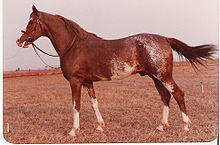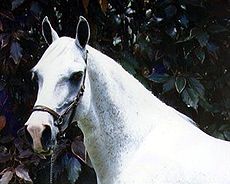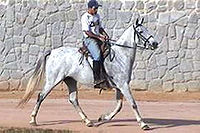- Mangalarga Marchador
-
Mangalarga Marchador 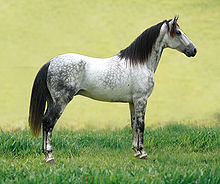
Country of origin Brazil Horse (Equus ferus caballus) The Mangalarga Marchador is a breed of horse. There are over 350,000 registered Mangalarga Marchador horses in Brazil and others registered in countries outside its Brazilian homeland. As an Iberian breed, descending from the Andalusian horse stallions of Portugal and Barb mares, supporters of the breed value them for their carriage, beauty and intelligence, good disposition and consider them easily trained for almost any discipline. The Marchador horses are known for having a smooth stable walk, canter and gallop as well as two natural ambling gaits: the diagonal batida and the lateral picada. They are valued for their endurance, versatility as stock horses, trail and pleasure riding animals as well as their ability to be trained in dressage or jumping.
Contents
History
The beginning
Francisco Gabriel Junqueira, Baron of Alfenas, decided to start a breeding experiment mixing his imported Royal Alter stallions with the common horse stock currently in his farm. The common stock was a mix of Barb horses (mostly) and other breeds that came to Brazil by the time of its colonization. The result of the Alter x colonial horse cross mix was a smooth-gaited, attractive horse. The Baron called these horses Sublimes.
Junqueira then sold some of the Sublimes to a friend who had a farm in Paty do Alferes in Rio de Janeiro state. The farm name was Mangalarga, and the owner used the Sublime horses when traveling to the Imperial capital, the city of Rio de Janeiro. In Rio, people noticed the smooth-gaited, attractive looking Sublimes and started to call them Mangalargas.
Breeders and researchers of the history of the Baron of Alfenas note that up through at least 1910 most of the ranchers involved in the development of the breed (especially the members of the Junqueira family) followed the Baron's original recommendations for selective breeding to fix the traits of the marching gait, hardiness, endurance, robust health and good temper.
The breed split
In 1934 the Mangalarga Breeders Association was created. The founders were motivated to establish a clear direction for breeding efforts, define the function and the use of the horses, and describe the desired characteristics of individuals in their functional and morphologic aspects, particularly to create a very clear definition of the intended gait.
The founders of that association had largely achieved the objectives that dated as far back as the period 1812-1816, when a number of breeders moved from Minas Gerais to São Paulo state. They had introduced bloodlines from several non-gaited horse breeds, including the (Arabian, Anglo-Arabian, Thoroughbred, Lusitano, and American Saddlebred. Theses mixes were intended to morphologically adapt the original Mangalarga to the "paulista" topography and culture with the minimum loss of smoothness of gait. Today, this blood remains in only a few female lines of the Mangalarga Marchador.
Because of this situation, there was an increase in the differences between breeders that wanted to maintain the original objectives and those that defended the new type of horse. The Mangalarga Breeders Association closed its Stud Book in 1943, about 9 years after its foundation. A group of breeders who disagreed with this decision met in 1948 to found the Association Mangalarga Marchador that became today's ABCCMM.
Thus, although there are two separate organizations today for the Mangalarga and the Mangalarga Marchador, and the resulting animals have different type and conformation, both breeds have a solid common base, and similar roots. One type is not considered inherently superior to the other.
In order to unite political factions and create a new Stud Book, the breeders counted on the political prestige and technical expertise of professor Geraldo Carneiro. Dr. Geraldo, a veterinarian and zoologist, was a friend and neighbor of the governor of Minas Gerais and future president of Brazil, Juscelino Kubitschek. His contacts and skills permitted him to preserve the original Marchador Horse, by means of founding a new association. There was a meeting called by a group of breeders in Hotel Gloria, in the city of Caxambu. Among those present was Dr. Joaquim Fernandes Braga, superintendent of the Animal Production Department of the state of Minas Gerais, Secretary of Agriculture, Industry, Trade and Labor. There were also personnel from the federal Ministry of Agriculture, making clear the interest and focus demonstrated by higher authorities. In this preliminary meeting, the Writs of Intention were signed by 22 major figures representing public workers, technicians and breeders.
The breed today
With more than 350,000 horses registered, the ABCCMM Brazilian Mangalarga Marchador National Association is the biggest registry office of any type in Minas Gerais state of Brazil.
The MMHAA was the first USA breed registry, founded in 2000 and began importing foundation Mangalarga Marchador horses beginning 2001. That breed registry and association did not succeed. Subsequently, the ABCCMM affiliate association, the US Mangalarga Marchador association (USMMA) was created in 2004. This is the official registry of horses born in North America, with some horses maintaining dual registration with the Brazilian ABCCMM.
With around two hundred foundation Mangalarga Marchador horses in the United States, they have been featured on Horse Talk TV, appeared in the 2002 Tournament of Roses Parade, performed at the Fiesta of the Spanish Horse, Western States Horse Expo in Sacramento, Equine Affaire in Pomona, Southern National Exposition in Perry, Georgia, and Equitana in Lexington, Kentucky and many more venues. They are represented well in the sports of endurance, mounted archery and mounted shooting.
There are Marchador breeders and owners in many states, and in 2007, the breed was introduced to Canada.
Breed characteristics
Type
Middle sized; agile; strong and proportionate structures; vigorous and healthy; visually light expression in the appearance; fine, smooth skin; smooth, silky fur; active and docile temperament. The withers are prominent with a proportionate back. The chest is deep and the quarters are muscular. The croup is sloping and the shoulders are well conformed with sound legs and hard feet, all coat colours are accepted.
Height
For males ideal is of 1.52 m, when there are admitted for the definite register at least 1.47 m and maxim of 1.57 m. For females ideal is of 1.46 m, when there are admitted for the definite register at least 1.40 m and maxim of 1.54 m.
Head
- Shape: triangular, well outlined, middle and harmonious, wide and flat forehead;
- Profile: right-lined in the forehead and of a straight profile.
- Eyes: remote and expressive, big, prominent, dark and living creatures, fine and flexible eyelids;
- Ears: averages, movable, parallel, quite introduced, directed up, of preference with the tips lightly turned for inside;
- Throat: it sets sail and quite definite;
- Mouth: of middle opening, fine, movable and firm lips;
- Nostrils: big, quite open and flexible;
- Throat Latch: wide and skinny.
Neck
Pyramidal shape, light form in general, proportional appearance, oblique, with strong musculature, presenting balance and flexibility, with harmonious insertions, being that of the body in the superior third of the chest. When light convexity is admitted, in males, in the dorsal edge - as expression of sexual secondary character - thinning, fine and silky manes.
The Gait
See also: AmblingThe gait of the Mangalarga Marchador is fast and smooth, with a natural amble, known as a "march". with the feet moving alternately laterally and diagonally. Due to this, there are moments of triple support, or three hooves on the ground. The marcha batida is a movement when the feet are placed diagonally, while the marcha picada is when the feet are moved laterally and separately.[1] The word picada in Portuguese means "light touch", and this gait is usually the smoother of the two, because the broken pace movement creates little vertical momentum. The picada is similar to the paso llano of the Peruvian Paso breed. The word batida means "to hit", and is similar to the trocha gait performed by the Paso Fino.[2]
On level ground, when marching at a normal pace, the horse will overstep slightly; in other words, the tracks of the hind feet will cover or slightly pass the tracks of the front feet. The marcha is said by breed aficionados to be very comfortable to ride. The breed does not trot or pace, but instead moves from the marching gait straight into a canter.[1]
References
- ^ a b "The Gait". US Mangalarga Marchador Association. http://usmarchador.com/marchador_gait.aspx. Retrieved 2008-12-04.
- ^ Harris, Claudia. "The Brazilian Paso or the Mangalarga Marchador". Gaited Horse Book and Gift Catalog. http://www.gaitedhorse.com/mangalar.htm. Retrieved 2008-12-04.
3. The Fabulous Floating Horses by Barbara Weatherwax
External links
- Mangalarga Marchador article in Portuguese
- ABCCMM - Brazilian National Association
- http://usmarchador.com - US Mangalarga Marchador Association and Registry
- http://namarchador.org - US Mangalarga Marchador Association new website
- http://www.eamm.de - European Mangalarga Marchador Assocation
Equine Equine science and
management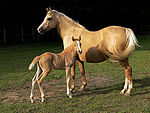
Equestrianism
and sportGlossary of equestrian terms · List of Equestrian Sports · Horse tack · Bit · Bridle · Saddle · Harness · English riding · Western riding · Driving · Horse training · Horse racing · Equestrian at the Summer Olympics (medalists, venues) · Horse show · EquitationEvolution and history Domestication · In warfare · In the Middle Ages · Horses in East Asian warfare · History of the horse in South Asia · Horses in the Napoleonic Wars · Horses in World War I · Horses in World War II · History of the horse in BritainHorse breeds, types
and other EquidaeList of horse breeds · Wild horse · Feral horse · Stock horse · Gaited horse · Draft horse · Warmblood · Sport horse · List of horse breeds in DAD-ISOther EquusHybridsCategory: Equidae Categories:- Horse breeds
- Horse breeds originating in Brazil
Wikimedia Foundation. 2010.

